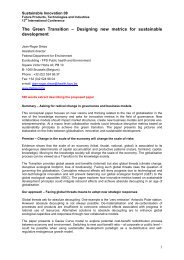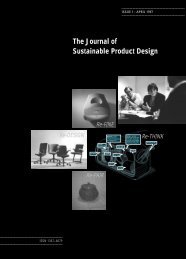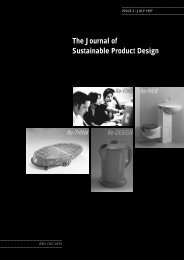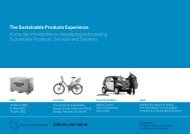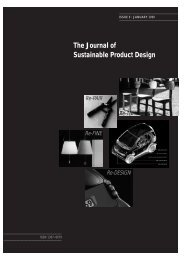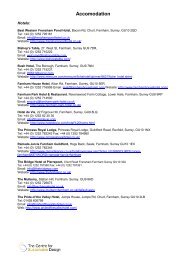Country report on the Indian electronics sector - The Centre for ...
Country report on the Indian electronics sector - The Centre for ...
Country report on the Indian electronics sector - The Centre for ...
Create successful ePaper yourself
Turn your PDF publications into a flip-book with our unique Google optimized e-Paper software.
14 · Asia Eco-Design Electr<strong>on</strong>ics (AEDE)<br />
<strong>the</strong> material suppliers to c<strong>on</strong>sider exploring e-waste streams<br />
as a raw materials source. <strong>The</strong> focus of original equipment<br />
manufacturers (OEMs) should be <strong>on</strong> design <strong>for</strong> disassembly and<br />
finding ways to fund this.<br />
Lead free solder paste cost factors<br />
Costs of compliance with RoHS depend mainly <strong>on</strong> <strong>the</strong> costs<br />
associated with substituting lead free comp<strong>on</strong>ents, capital<br />
equipment, and materials. A Prismark study estimates <strong>the</strong><br />
following cost increases <strong>for</strong> RoHS compliant products. <strong>The</strong>se<br />
may be used as a benchmark by <strong>Indian</strong> industry.<br />
Cost factors Percentage increase in paste cost<br />
Metal cost premium (more tin and silver) 7%<br />
Patent royalty payment 5–9%<br />
Higher energy costs to make alloy 3–8%<br />
More complex process (three comp<strong>on</strong>ent alloy) 1–3%<br />
NRE-Research (flux, stencil properties, aging, etc.) 10–20%<br />
Total initial cost increase (at <strong>the</strong> current stage) 36% average<br />
Total steady state high volume cost adder (future) 20%<br />
Source: Prismark Partners LLC (www.prismark.com)<br />
In <strong>the</strong> case of PCBs, shifting to lead-free processes may not<br />
be costly and price variance is expected to be unlikely at least<br />
in <strong>the</strong> medium term. But <strong>the</strong>se lead-free PCBs warp or crack<br />
under <strong>the</strong> required high temperatures <strong>for</strong> lead-free solder. Not all<br />
are able to resolve this problem quickly. This might translate to<br />
higher costs.<br />
For substrates that c<strong>on</strong>tain lead, e.g. flip-chip ball grid array<br />
(BGA) packaging, <strong>the</strong> cost hike is anticipated to be 10% <strong>for</strong> <strong>the</strong><br />
substrate to be RoHS compliant. This cost is likely to be passed<br />
<strong>on</strong> to <strong>the</strong>ir customers who are chipset makers and can finally be<br />
passed <strong>on</strong> to mo<strong>the</strong>rboard manufacturers.<br />
Passive comp<strong>on</strong>ents like capacitors and chip resistors are<br />
particularly susceptible to damage from <strong>the</strong> hotter lead-free<br />
process calling <strong>for</strong> greater cauti<strong>on</strong> and expertise in adapting to<br />
alternate substances. Japanese players dominate <strong>the</strong> passives<br />
market with Murata, TDK, Taiyo Yuden having l<strong>on</strong>g experience<br />
in supplying similar parts to <strong>the</strong> branded Japanese giants.<br />
C<strong>on</strong>versi<strong>on</strong> to lead-free by Semco and Yageo was <str<strong>on</strong>g>report</str<strong>on</strong>g>ed to<br />
be complete with negligible cost implicati<strong>on</strong>s. <strong>Indian</strong> companies<br />
can use <strong>the</strong>m as benchmarks.<br />
O<strong>the</strong>r expenses and risks include testing. Costs associated<br />
with testing include high priced testing equipment, labour and<br />
associated administrative expenses.<br />
Since most companies will offer both RoHS compliant and<br />
n<strong>on</strong>-RoHs compliant products <strong>for</strong> some time to come, inventory<br />
risk management will become an important and additi<strong>on</strong>al task.<br />
Initially, assemblers and distributors will have to keep track of<br />
twice as many parts. A thorough evaluati<strong>on</strong> and planning of <strong>the</strong><br />
assembly process would be necessary <strong>for</strong> <strong>Indian</strong> companies to<br />
overcome <strong>the</strong>se hurdles to lead-free assembly.<br />
It is clear that compliance measures will require substantive<br />
investment from <strong>Indian</strong> companies covering costs of productredesign,<br />
re-tooling of producti<strong>on</strong> lines, new materials, new<br />
processes, product testing facilities (in-house and third parties),<br />
pers<strong>on</strong>nel training, c<strong>on</strong>sulting expenses and <strong>the</strong> writing-off of<br />
discarded hazardous products and materials. As compliance<br />
standards keep rising, investment costs are bound to increase.<br />
In some cases costs have been reduced, although marginally,<br />
such as in <strong>the</strong> case of a medium sized company manufacturing<br />
Semic<strong>on</strong>ductors. Historically, <strong>the</strong>y used potassium dichromate<br />
soluti<strong>on</strong> as pre cleaners in axial diodes prior to lead finish. A n<strong>on</strong><br />
hazardous chemical MICROPREP 18 was tried and found to<br />
be a substitute which resulted in <strong>the</strong> eliminati<strong>on</strong> of chrome from<br />
<strong>the</strong> process, and costs were reduced both in manufacturing<br />
and effluent treatment by approx Rs.100,000 (US$ 2300<br />
approx.) per year. <strong>The</strong> company also substantially reduced<br />
<strong>the</strong> c<strong>on</strong>sumpti<strong>on</strong> of power per microchip manufactured and<br />
similarly reduced <strong>the</strong> c<strong>on</strong>sumpti<strong>on</strong> of water.



